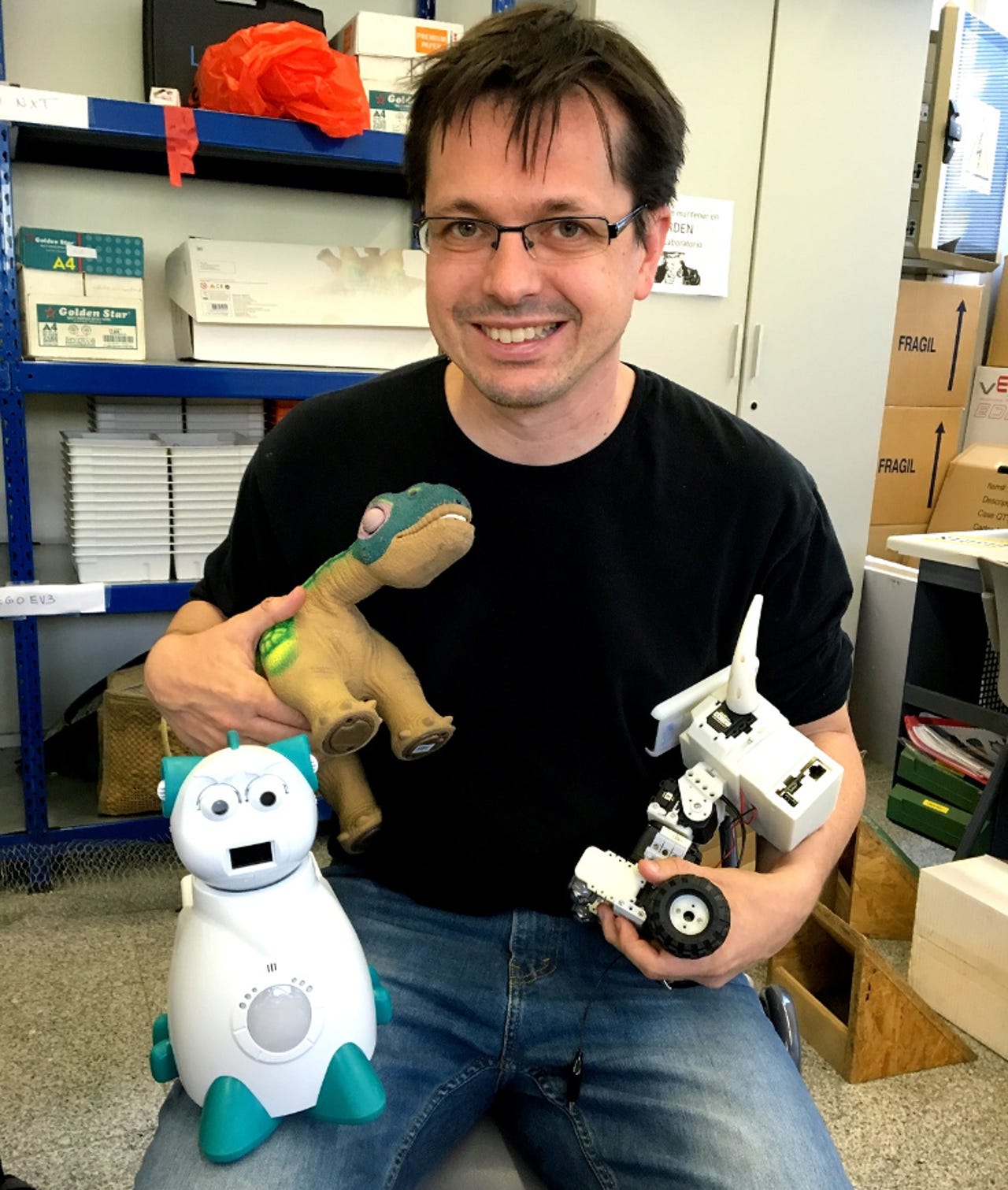Robocare: Part pet, part nurse, all robot - the future of care for sick children?

Jordi Albó-Canals with the Linux-based AiSoy educational emotional robot, bottom left, and the PLEO dinosaur-like robot, left: "The child generates data and this data can improve the robot, then the therapy."
Jordi Albó-Canals lives between Boston, Panama City, and Barcelona, in a career dedicated to robots. The Catalan engineering professor has worked at MIT and combines his job at the robotics group at La Salle Campus Barcelona, Universitat Ramon Llull, with multiple research projects.
Some years ago, he discovered the impact of robotics in education through the First Lego League. This international competition pits elementary and middle school teams against one other in building and programming robots.
Once he had glimpsed the possibilities of robotics in this area, he decided to devote his professional life to developing educational and therapeutic robots to help children. He believes these machines should be social, low-cost robots, connected to the cloud.
Albó-Canals says robots have an incredible potential to help children improve social skills and problem-solving.
"A global study of children, aged 12 years and under, has found that 64 percent of them treat robots as if they were animals or people," he says.
At Barcelona's Hospital Sant Joan de Déu, where robots have been integrated as companions for hospitalized children, nursing research coordinator Miquel Garcia agrees that robots are much more than just technological toys.
"They're a key part of the distraction therapy applied by health professionals to treat children. Patients who are in oncology, for example, want to have them for their chemotherapy sessions," he says.
"They need to take care of them, feed them, so that a special bond is forged. This is a great help in improving communication with direct-care workers," he explains. Plus, the process is less intimidating for the patient.
The robot therapy project at Hospital Sant Joan de Déu started five years ago as an alternative to pet therapy in the context of the research program led by Albó-Canals and driven by a consortium formed by LaSalle, the Polytechnic University of Catalonia and the hospital.
In the first phase of the research, the hospital used up to 10 robots, Garcia says. Later, a family who was very pleased with the results achieved by the robots in the treatment of their child bought a further five machines for the hospital.
Yet, the tech pets are machines, and machines malfunction and break down. So now, just three of them still work, and are rotated between oncology, outpatient surgery, and psychiatry, an area where a special program for children with Autism Spectrum Disorder, or ASD, has been developed.
This program has been exported to Tufts University, Boston, and the Centro Ann Sullivan Panamá. In both facilities, group therapy is applied with the robot acting as a facilitator.
The care companion most commonly used in Sant Joan de Déu is PLEO, a dinosaur-like robot, developed with commercial software called VIDA OS, which means life in Spanish.
"Children love him. Each model has a different name and unique qualities that distinguish it from the others. Patients know exactly who is who," Garcia says.
In Boston, engineering professor Albó-Canals works with three different types of robots, each equipped with a sensory system and remote controlled via a cloud-based system. They interact with children through gestures and expressions, lights, sounds, and even speech.
The models are called NAO, AISoy, and CEEO-Tufts. NAO, the tallest at 58cm high, is a humanoid robot piloted by a made-to-measure operating system developed by Aldebaran Robotics.
AiSoy, based on Linux, is an educational emotional robot created by Spanish company AISoy Robotics. Finally, CEEO-Tufts is the robotic platform based on Arduino YUN developed at Tufts by Albó-Canals' research team.
"The most interesting thing is that the interaction that occurs with the child generates data and this data can improve the robot, then the therapy," Albó-Canals says. This opens up many possibilities.
"For example, a robot can know the heartbeat of a child and change its behavior depending on what this child needs," he says.
Albó-Canals and his team are already working on an improved version of PLEO, called CASPER, which currently looks like a turtle.
Sant Joan de Déu's Garcia is looking forward to the arrival of the new robot but recognizes that the process is slow, with funding a major issue for advancing the project in the coming years. But for the moment he is focusing on increasing the number of robots helping children at the hospital.
"We are awaiting a grant to buy more robots and make a Jurassic park where children can share their experiences concerning robots," he says.
Oddly enough, Garcia says, professional care-givers feel comfortable with the role of the robots and don't feel threatened.
"Technological changes tend to scare us, but the experience with robots is still very good. Everyone has accepted them because they make our everyday tasks easier," he says.
Professor Albó-Canals is convinced that robots will find more roles in new fields.
"We don't seek to replace the therapist or the nurse but to improve their performance," he says. He is focused on the augmented workforce, where robotics is used to free highly-skilled workers to apply their talents where they are most needed.
That approach is now creating a "new business model in the field of robotics", he says.
The PLEO care companion is a dinosaur-like robot, developed with VIDA OS commercial software.
